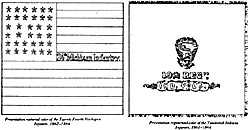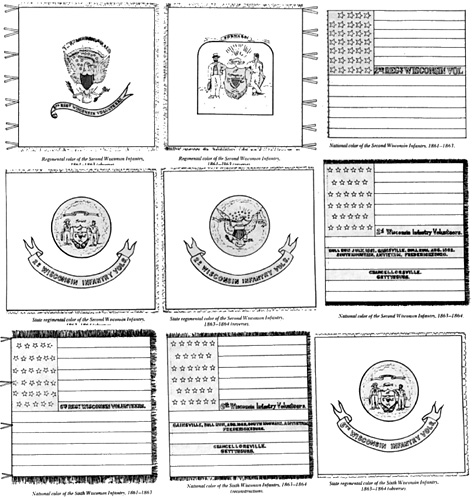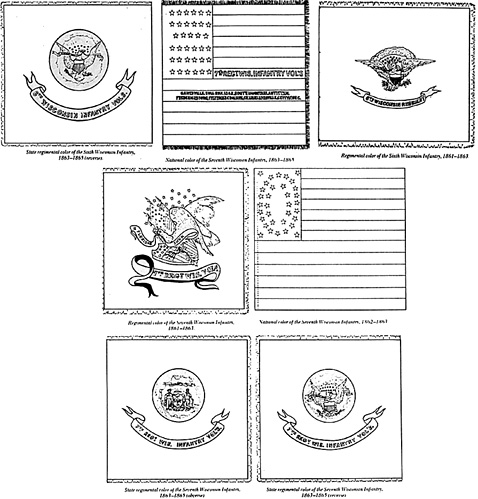 The Iron Brigade was mentioned on more membership applications than any other unit that fought in the Civil War. It is our pleasure to bring you a very special presentation courtesy of the State Historical Society of Wisconsin's Iconographic Collection.
The Iron Brigade was mentioned on more membership applications than any other unit that fought in the Civil War. It is our pleasure to bring you a very special presentation courtesy of the State Historical Society of Wisconsin's Iconographic Collection.
Left: Presentation color of 24th Michigan (1862-64). Right: Presentation color of 19th Indiana (1861-64).
There is much written about the history and battles of the Iron Brigade. To repeat such in these pages would be unecessary. However, the following illustrations by Robert D. Needham show every flag used by this fighting brigade during the war. Needless to say, wew were thrilled to have the opportunity to share the drawings with you.
There is no better summary of the Iron Brigade than that found in The Encyclopedia of the Civil War. In severe capsule form, here is their history:
In Autumn 1861, in Washington, D.C., the 2nd, 6th, and 7th Wisconsin, and the 19th Indiana regiments were organized as a brigade, the only all-Western brigade in the Army of the Potomac. It's first commander was Brigadier General Rufus King. When corps were created in 1862, it was assigned to the I Corps.
Brigadier Genl. John Gibbon became commander of the brigade May 1862, improving its training and discipline and giving it the black felt hats that came to symbolize the unit. The brigade's first major action was at Groveton, August 28, 1862, where it lost 751 men (33% of its strength). At South Mountain, september 14, 1862, it lost 318 men (25%). Its heroic conduct on that day led the I Corps commander, Major Genl. Joseph Hooker, to refer to it as his "iron brigade. At Antietam 3 days later, the Iron Brigade lost another 348 men (42%).
In Fall 1862 the 24th Michigan was added to the brigade, bringing much needed reinforcements and preserving its all-Western character. The unit was only slightly engaged at Fredericksburg and Chancellorsville.
On July 1, 1863, the brigade was with the I Corps as it deployed to defend McPherson's Ridge and Seminary Ridge west and northwest of Gettysburg. In the heavy fighting that followed, it slowed the Confederate advance and thereby gained time for the deployment of other units. It paid a heavy price, losing 1212 of its 1883 men (65%); the 24th Michigan lost 807, the 2nd Wisconsin 777, and the 19th Indiana 727.
The battle of July 1st destroyed the Iron Brigade, but the name continued in use. Eastern regiments were added to the brigade, draftees and substitutes came into the ranks, and old regiments left the service as their time expired or they were consolidated with other units. Only the memory of the old brigade lingered.
Flags
Top to bottom, left to right:
1st Row: Regimental color of 2nd Wisconsin (1861-63)[obverse]. Regimental color of 2nd Wisconsin (1861-63) [reverse]. Right: National color of 2nd Wisconsin (1861-63).
2nd Row: State Regimental color of 2nd Wisconsin (1863-64)[obverse]. State Regimental color of 2nd Wisconsin (1863-64) [reverse]. Right: National color of 2nd Wisconsin (1863-64).
3rd Row: National Regimental color of 6th Wisconsin (1861-63). National Regimental color of 6th Wisconsin (1863-64). Right: State Regimental color of 6th Wisconsin (1863-64) [obverse].

1st Row: State Regimental color of 6th Wisconsin (1863-65) [reverse]. National color of 6th Wisconsin (1863-65). Right: Regimental color of 6th Wisconsin (1861-63).
2nd Row: Regimental color of 7th Wisconsin (1861-63). National color of 7th Wisconsin (1862-63).
3rd Row: State Regimental color of 7th Wisconsin (1863-65). State Regimental color of 7th Wisconsin (1863-65).

Back to The Zouave Vol I No. 3 Table of Contents
Back to The Zouave List of Issues
Back to Master Magazine List
© Copyright 1987 The American Civil War Society
This article appears in MagWeb (Magazine Web) on the Internet World Wide Web.
Other military history articles and gaming articles are available at http://www.magweb.com